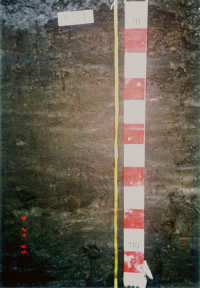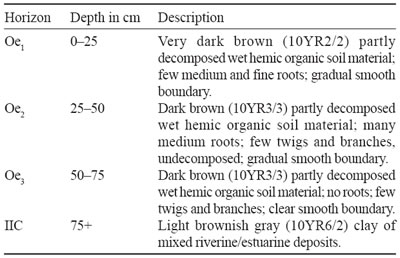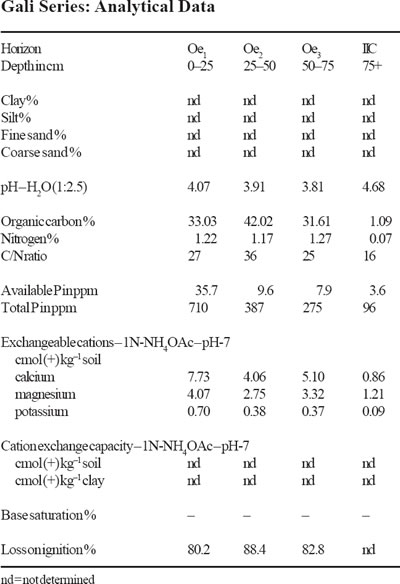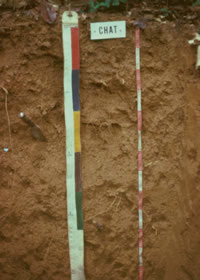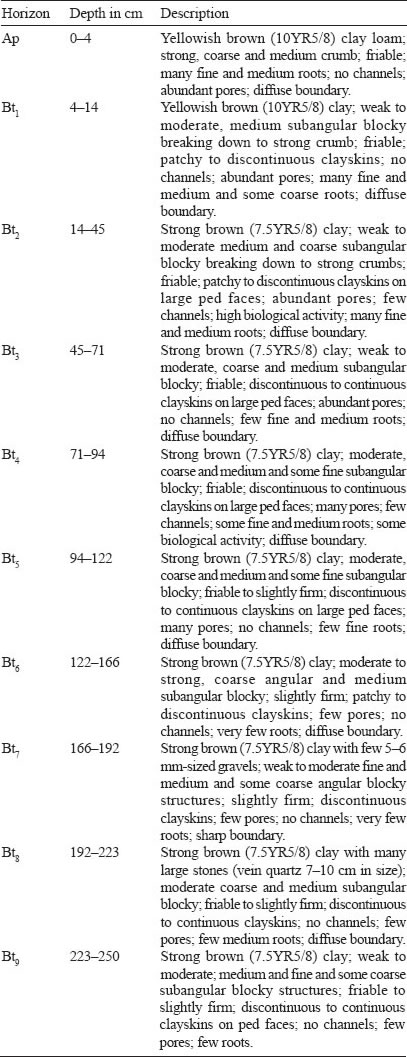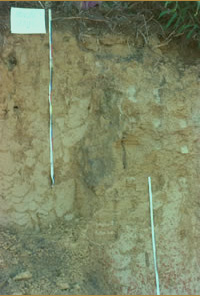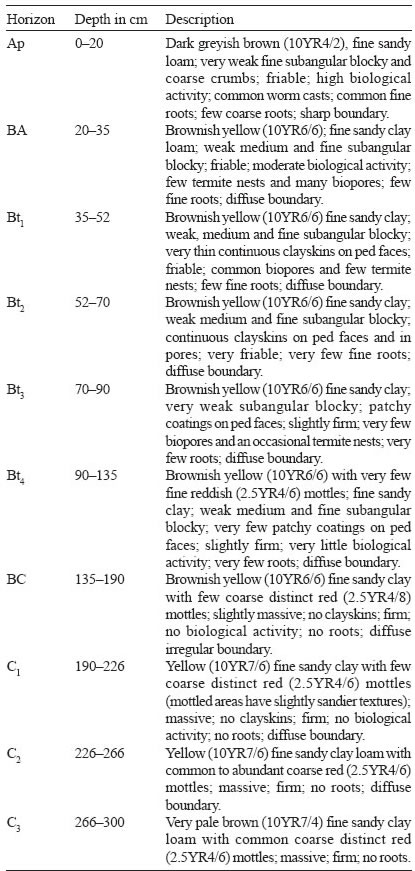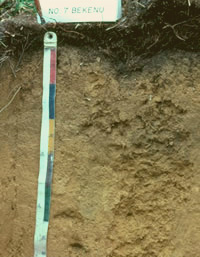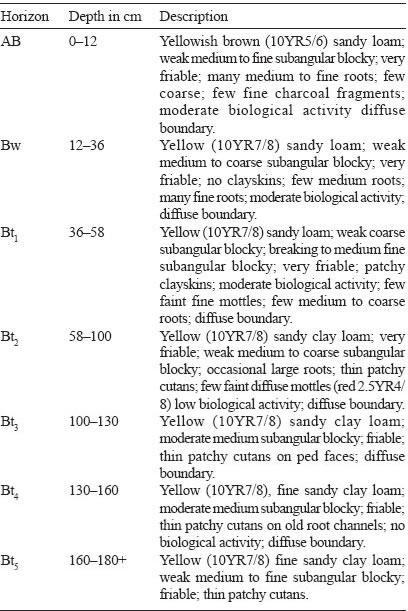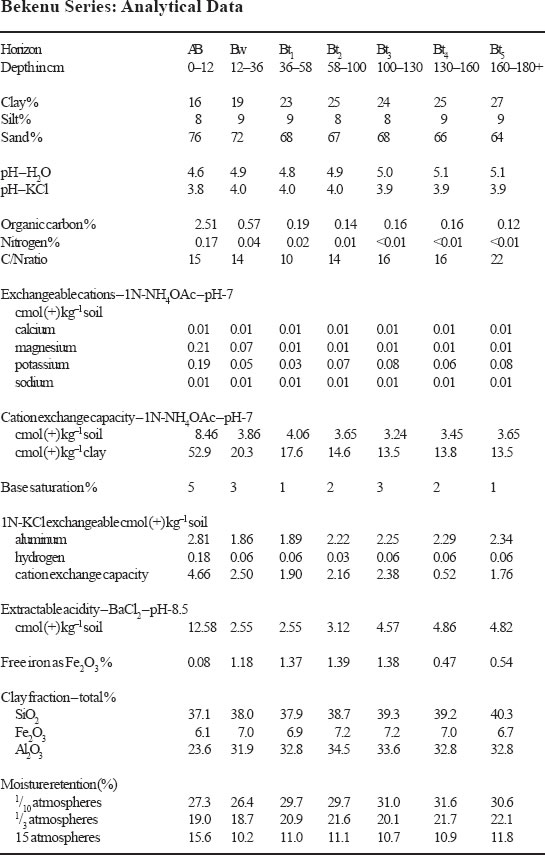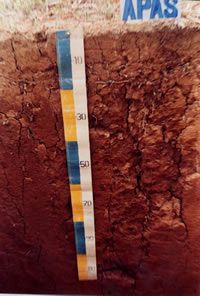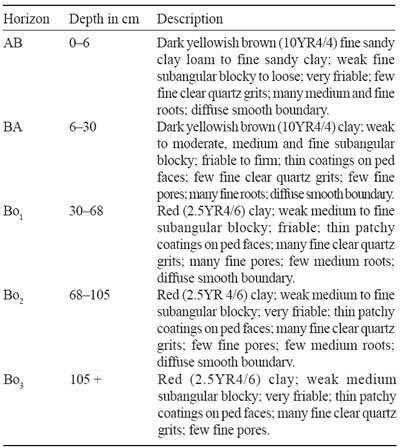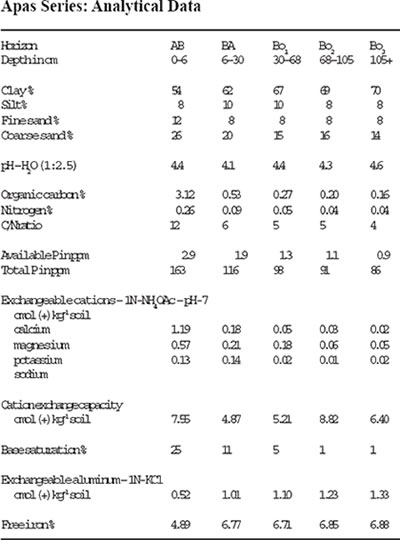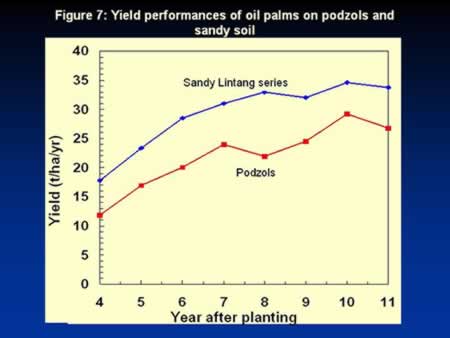Soil Profiles: Gali
Gali Series
The Gali Series is a member of the Gali Family which is a riverine-clayey, dysic Hemik (Terrik) Topogamborgs. It typifies this family and is autochthonous, low-ash, non-woody. These are shallow to moderately deep (50–150 cm) organic soils which are found in narrow valleys and inland swamps often in areas with sedimentary rocks. They have a high water table (unless artificially drained) and terric or hemic material form the dominant material in the subsurface tier. The underlying mineral soils in these organic soils occur at depths between 50 to 150 cm and consists of clay of riverine or colluvial origin. These soils have a low ash content and are dysic in the surface tier. The organic materials in these soils are generally non-woody.
Type Location
Soils of the Gali Series were first proposed and established during the Semi-Detailed Soil Survey of the Terengganu River Basin (Biot et al. 1982) but no description and analytical data were available in that report. The above pedon was described in the Rompin area of Pahang in a swamp forest. Location: Topographic Sheet 4456, 2°43’27” N, 103°32’12” E (Grid Reference 4456 – 155018 m).
Range in Characteristics
Little is known about the range in characteristics of the Gali Series. From what is known to-date the organic soil layer is dominantly hemic and non-woody and extends to a depth of 50 cm to 150 cm. The underlying mineral substratum is generally clayey (> 15% clay) and is alluvium/colluvium derived from sedimentary rocks. These soils can have a surface tier that is fibric, hemic and has a low ash content. Commonly the mineral soils are encountered below 75 cm depth.
Competing Soils and Their Differences
To-date a total of 18 soil series have been mapped as soils having shallow to moderately thick (50–150 cm) organic deposits. Of these only four soil series, namely the Bakri, Gali, Pak Bong and Tasik Series have hemic organic soil materials dominating the subsurface tier (50–100 cm). Both the Gali and Tasik Series are underlain by riverine/colluvial clays. Soils of the Gali Series are differentiated from the Tasik Series by the ash content in the surface tier. The Bakri Series has hemic materials in the subsurface tier but the underlying mineral material is marine-clayey and sulfidic.
Setting
Soils of the Gali Series are found in inland valleys or swamps found between hills of sedimentary rocks. Thus the underlying mineral soils are often clayey.
Principal Associated Soils
Little is known about the soils commonly associated with soils of the Gali Series. In the inland swamp situations these soils could be associated with other organic soils such as the Tasik, Pak Bong or Gadong Series. Where sedimentary rocks occur adjacent to the beach ridges these soils could occur close to the Igan, Mukah and Epai Series.
Drainage and Permeability
In their natural state soils of the Gali Series are permanently under water and are very poorly drained. When drained, shrinkage and decomposition of the organic materials takes place fairly rapidly. These soils may then no longer be classified as the Gali Series.
Use and Vegetation
In their natural state, soils of the Gali Series are mainly under sedges, grasses and shrub vegetation. Locally some of these areas have been drained and planted with vegetables.
Distribution and Extent
It is expected that soils of the Gali Series form small inland swamps in areas where sedimentary rocks form the hills. The actual distribution and extent is not known. To-date these soils have been mapped in Terengganu and locally in some other states.
Series Established
The Gali Series was first established in Terengganu, Peninsular Malaysia by Biot et al. (1982). It is not clear where the name was derived from.
Remarks on Classification
The Gali Series is classified here according to the Malaysian Soil Taxonomy – Second Approximation (Paramananthan 1998) as a member of the riverine- clayey, dysic family of Hemik (Terrik) Topogamborgs which is autochthonous, low ash, non-woody. They are classified as shallow to moderately deep (50–150 cm) organic soils in which hemic and terric materials dominate the subsurface tier (50–100 cm). The underlying mineral soil is riverine clayey (> 15% clay) and the organic layer is autochthonous and non-woody. The surface tier (0–50 cm) is both dysic and of low ash content. In the Keys to Soil Taxonomy – Eighth Edition (Soil Survey Staff 1998) this soil would be classified as Terric Haplohemists. In the FAO/UNESCO Soil Map of the World – Revised Legend (FAO 1990) this soil would probably be classified as Fibric Histosols.
Suitability for Agriculture
In their natural state, soils of the Gali Series are permanently under water and hence not suitable for agriculture. Once drained these soils can be used for the cultivation of vegetables, tapioca, sago and oil palm. However special management is required on these soils especially in relation to trace elements – copper, boron and zinc.
Soil Profiles: Chat
Chat Series
The Chat Series is a member of the Lanchang Family which is a very fine, kaolinitic, isohyperthermic, red-yellow Tipik Lutualemkuts. It is developed over fine grained sedimentary rocks. The soils have brown to yellowish brown clay to clay loam A horizons. The B horizons are deep and uniform with strong brown to yellowish brown colours and heavy clay textures. At depths below 70 cm the colours may become yellowish red. At depth, occasionally a layer of vein quartz may be present. The structures are weak to moderate, medium subangular blocky with friable consistence and patchy to discontinuous clayskins occur on ped faces. These soils have been identified over iron-rich shales sometimes having veins quartz. These soils have a kandic horizon and hence must have a CECclay of less than 16 cmol (+) kg–1 clay in all subhorizons between 25 to 100 cm depth. No significant clay decrease to 100 cm depth is permissible.
Type Location
The Chat Series was first established by Lim (1977). The above pedon was from the type locality along a timber tract between Benta town and Kampong Chat near Jerantut, Pahang, on rolling topography (6–12°) at an elevation of about 80 metres (250 ft). Location: Topographic Sheet 3860, 3°58’50” N, 101°59’20” E (Grid Reference 3860 – 435395 m).
Range in Characteristics
The Chat Series was formerly mapped as the Munchong Series. In the past the Munchong Series included soils with both with an oxic as well as an argillic or kandic horizons. Those having a deep kandic horizon and predominantly strong brown colours are now reclassified as the Chat Series. These soils also must have a CECclay of less than 16 cmol (+) kg–1 clay in all subhorizons between 25 to 100 cm depth. The A horizons of the Chat Series have colours ranging from brown yellowish brown to dark yellowish brown (10YR4/4, 4/6, 5/3, 5/4, 5/6, and 7.5YR5/4) and clay to clay loam textures. The upper part of the B horizons of the Chat Series often has yellowish brown, strong brown and rarely reddish yellow colours (10YR5/6, 5/8; 7.5YR5/6, 5/8, 6/6, 6/8) and uniformly clay textures. Hues of 5YR may be permitted but cannot occur within 50 cm of the surface. Very often the strong brown colours (7.5YR5/8) colours extend uniformly to great depths. The clay contents in the B horizon average over 65% and increase slightly with depth. The structures in the B horizons are weak to moderate medium subangular blocky and consistence is friable. The structures become slightly stronger and consistence slightly firm with depth. A stoneline often of fine nodular petroplinthite and/or stones of vein quartz may be present at depths below 1.25 m. Clayskins which are often patchy in the upper but discontinuous in the lower part of the B horizon are a distinctive feature of these soils.
Competing Soils and Their Differences
The 10YR and 7.5YR hues of the Chat Series in the upper part of the B horizon distinguishes this soil from the Segamat, Prang, Kampong Kolam and other redder soils. The presence of an kandic horizon separates the Chat Series from the Munchong, Jerangau and Katong Series. The Lanchang Series has similar colours but appears to have more medium to coarse sand than the Chat Series as it is developed over granodiorite. The Yong Peng Series on the other hand has textures which are more silty. The Lanchang and Yong Peng are developed from igneous rocks – granodiorite and dacite respectively while the Chat from shales. A soil referred to by some surveyors as the Razak Series is similar to the Chat Series and is hence this name should no longer be used. The clay content of more then 60% separates the Chat Series from the Bungor, Bedup, Kumansi/deep and Serdang Series. The Ulu Dong Series has redder colours and has more than 60% clay. Soils of the Melugu, Stass and Padawan Series also have more than 60% clay but have CECclay values exceeding 16 cmol (+) kg–1 clay in some subhorizon within 25 to 100 cm depth.
Setting
Soils of the Chat Series have been mapped on undulating to hilly terrain. They have been mapped at elevations ranging from 15–100 m (50–300 ft).
Principal Associated Soils
The Chat Series is often associated with soils of the Munchong, Serdang, Malacca, Gajah Mati and Prang Series. The Serdang Series is developed over quartzites and sandstones and has sandy clay loam textures and brownish yellow to yellowish brown colours. The Malacca and Gajah Mati Series are characterized by a thick band of lateritic nodules occurring within 50 cm of the surface. The Prang Series has hues which are much redder (2.5YR and 5YR) within 50 cm of the soil surface and has an oxic horizon. The Bungor Series has a fine sandy clay texture with more fine sand, consistence is firmer and structures are better developed. The colours of the Bungor Series are also often yellower than that of the Chat Series.
Drainage and Permeability
Soils of the Chat Series are well drained and have a good permeability.
Use and Vegetation
Rubber, oil palm and fruit trees are the main crops grown on this soil. In parts of Pahang and Kelantan, some of these soils may still be under primary forests.
Distribution and Extent
The actual distribution of these soils is not known. However, it appears that many of the areas mapped as Munchong Series in the past may be Chat Series. These soils have so far been identified in Selangor, Pahang, Johore and Kelantan. They may also be present in Sabah and Sarawak.
Series Established
This soil was established near Kampong Chat just south of Benta town in Pahang. The source of name is Kampong Chat, Pahang, Peninsular Malaysia.
Remarks on Classification
The Chat Series is classified here according to the Malaysian Soil Taxonomy – Second Approximation (Paramananthan 1998) as a member of the very fine, kaolinitic, isohyperthermic, red-yellow family of Tipik Lutualemkuts. They are classified as soils have a thick kandic horizon in which the clay contents increases or remains constant to a depth of over 100 cm and have a CECclay of less than 16 cmol (+) kg–1 clay between 25 to 100 cm depth. In the Keys to Soil Taxonomy – Eighth Edition (Soil Survey Staff 1998) the Chat Series are probably Typic Kandiudults. In the FAO/UNESCO Soil Map of the World – Revised Legend (FAO 1990) these soils would be classified as Haplic Nitisols.
Suitability for Agriculture
The Chat Series appears to be a highly suitable soil for agricultural development. The terrain is probably the major limitation in these soils. In areas where droughts or low rainfall is experienced these soils can give rise to moisture problems particularly during the establishment of the crop.
Soil Profiles: Bungor
Bungor Series
The Bungor Series is a member of the Bungor Family which is a fine, kaolinitic, isohyperthermic, red-yellow Tipik Lutualemkuts. It typifies the family and is developed over mixed sedimentary rocks. These soils are characterized by dark greyish brown A horizons with fine sandy loam textures and deep B horizons having brownish yellow to yellowish brown colours and fine sandy clay textures. Consistence is friable and becomes firmer with depth. The structures are weak to moderate medium and fine subangular blocky. At depths below 75 cm few medium to coarse distinct red mottles may appear. At depths below 150 cm the colours become paler. This soils is developed over interbedded sandstones and shales or sandy shales. These soils have a kandic horizon and must have a CECclay of less than 16 cmol (+) kg–1 clay in all subhorizons between 25 to 100 cm depth. No significant clay decrease to 100 cm depth is permissible.
Type Location
The Bungor Series was first established on the western part of lower Sungei Lepar Valley in east Pahang by Libby (1964) during the Reconnaissance Soil Survey of Lepar Valley, Pahang. The above pedon was described on a 12° slope in undulating terrain near the village of Sri Jaya at the 37th milestone Kuantan- Temerloh Road. Location: Topographic Sheet 4259, 3°40’20” N, 102°52’40” E (Grid Reference 4259 – 426060 m).
Range in Characteristics
Soils of the Bungor Series show very little variation in the areas mapped to-date. They have colours which range from strong brown, brownish yellow and yellowish brown (7.5YR5/6; 5/8; 10YR5/6, 5/8, 6/6, 6/8). Rarely the colours may be reddish yellow (7.5YR6/6, 6/8). Textures range from fine sandy loam to fine sandy clay loam to clay. Clay contents seldom exceed 50% and fine sand always dominates the coarse sand which seldom exceeds 20%. Structures are weak to moderate medium and fine subangular blocky and consistence friable to firm with depth. Red mottles often appear at depths below 75 cm and increase with depth. The depth of the soil though often deep may sometimes be shallow on steep slopes as they grade into the Kuala Brang and Kuah Series. Some soils of the Bungor Series have a thin band of nodular petroplinthite but the band cannot exceed 25 cm in thickness. As defined here soils of the Bungor Series must have a CECclay of less than 16 cmol (+) kg–1 clay in all subhorizons between 25 to 100 cm depth.
Competing Soils and Their Differences
Soils of the Bungor Series are very similar to soils of the Serdang, Batang Merbau, Munchong Series and Jerangau Series. Both the Munchong and Jerangau Series may have similar colours to the Bungor Series but are heavier textured and have oxic horizons. The distinction between the Bungor Series and the Batang Merbau and Serdang Series is difficult. The Batang Merbau Series has a sand fraction dominated by medium sand while the Bungor Series is dominated by fine sand. The Bungor Series in the field does not show up any coarse sand and even the fine sand is so rounded that it is often not felt. The Serdang Series has fine sandy clay loam textures. The Batang Merbau Series also is reported to have mica flakes throughout the profile as it is developed over mica schists. Some of the Durian Series mapped in the past also may have 7.5YR hues but these have much siltier textures, redder colours at shallow depths, shallower profiles and very firm consistence. The Kuala Brang Series which has many features similar to the Bungor Series is a moderately deep equivalent of the Bungor Series and the saprolite is encountered within 100 cm. Soils of the Bungor Series can be easily mistaken for the Bedup Series (Sarawak) and Kumansi Series/deep (Sabah) or Merit Series (Sarawak) but these soils have a CECclay of more than 16 cmol (+) kg–1 clay in some subhorizon between 25 to 100 cm depth.
Setting
Soils of the Bungor Series are developed over interbedded sandstones and shales or sandy shales. They have been mapped over a wide range of terrain ranging from gently undulating to steep. The commonest range is undulating to hilly.
Principal Associated Soils
Soils of the Bungor Series have often been mapped in association with soils of the Serdang and Munchong Series. The Serdang Series has fine sandy clay loam textures, is more friable and weaker structured than the Bungor Series. The Munchong Series on the other hand is heavy clay textured, more friable and has an oxic horizon. As defined here soils of the Bungor Series may now be associated with soils of the Bedup, Kumansi/deep and Merit Series from which it can be differentiated using the CECclay values.
Drainage and Permeability
Soils of the Bungor Series are well drained and have a good permeability.
Use and Vegetation
Soils of the Bungor Series are commonly planted with a variety of crops including rubber, oil palm, fruit trees, cocoa. Some of these areas are still under primary forest vegetation.
Distribution and Extent
The Bungor Series is fairly well distributed in Peninsular Malaysia. It has been mapped in Perak, Selangor, Negeri Sembilan, Johore, Malacca, Pahang, Terengganu and Kelantan. Their extent is however not known.
Series Established
The soil was established during the Reconnaissance Soil Survey of the Lepar Valley, Northeast Pahang (Libby 1964). The source of name is the village of Paya Bungor on the Kuala Lumpur-Kuantan road.
Remarks on Classification
Soils of the Bungor Series are classified here according to the Malaysian Soil Taxonomy – Second Approximation (Paramananthan 1998) as a member of the fine, kaolinitic, isohyperthermic, red-yellow family of the Tipik Lutualemkuts. They have a deep kandic horizon which has a low base status and in which the clay content does not decrease significantly within 1.0 m of the surface. The CECclay is less than 16 cmol (+) kg–1 clay in all horizons between 25 to 100 cm depth. Soils of the Bungor Series would be classified as Typic Kandiudults in the Keys to Soil Taxonomy – Eighth Edition (Soil Survey Staff 1998). In the FAO/ UNESCO Soil Map of the World – Revised Legend (FAO 1990) they will be classified as Haplic Nitisols.
Suitability for Agriculture
These soils are some of the better sedentary soils found in Peninsular Malaysia. Terrain should be the major limiting factor in these soils. Their fertility status like most soils in this country is low.
Soil Profiles: Bekenu
Bekenu Series
The Bekenu Series is a member of the Bekenu Family which is fine loamy, siliceous, isohyperthermic, red-yellow to yellow Tipik Tualemkuts. It typifies the family and is developed over mixed sedimentary rocks. Soils of the Bekenu Series are redefined here as being characterized by their deep, well drained profiles with brownish yellow to yellow subsoil colours dominating the subsoil. These soils have an argillic horizon with fine sandy clay loam textures and a ECECclay of less than 24 cmol (+) kg–1 clay in all subhorizons between 25 to 100 cm depth. Structures are weak medium to coarse subangular blocky and consistence is friable. Patchy clayskins occur on ped faces.
Type Location
Soils of the Bekenu Series were first described by Andriesse (1972) during the reconnaissance soil survey of West Sarawak. The above pedon was described by Lim Chin Pang for the CLAMATROPS Tour II organised by the Malaysian Society of Soil Science in 1977 at the 24th milestone Bau-Lundu Road in West Sarawak. The pedon was located on rolling (12–24% or 6–12° slopes) terrain at an elevation of 50 metres (150 feet). The vegetation was logged lowland Dipterocarp Forest. Location: Topographic Sheet 1/109/8, 1°33’20” N, 109°54’00” E (Grid Reference 1/109/8 – 892715 m).
Range in Characteristics
In the past in Sarawak, soils of the Bekenu Series were mapped as Red-Yellow Podzolic soils which can either have a cambic, kandic or argillic horizon with hues of 10YR or 2.5Y with any CECclay value. They are redefined here as soils having only an argillic horizon with red-yellow to yellow colour class and a CECclay of less than 24 cmol in all subhorizons between 25 cm to 100 cm depth. Little is known about the range in characteristics of the Bekenu Series. They generally occur on rolling, hilly to steep terrain. On the steeper terrain the profiles become moderately deep and are no longer the Bekenu Series. Textures in this soil are uniformly fine sandy clay loam and colours are brownish yellow, yellow to olive yellow (10YR6/6–6/8, 7/6–7/8, 8/6–8/8; 2.5Y6/6–6/8, 7/6–7/8, 8/6–8/8). Structure are generally weak medium to coarse subangular blocky and consistence friable. Patchy clayskins are often present. Only the deep soils are retained as belonging to the Bekenu Series in this redefinition. CECclay values are higher than 16 but less than 24 cmol (+) kg–1 clay. In some profiles a few subhorizons may have a CECclay of less than 16 cmol in the 25 to 100 cm depth.
Competing Soils and Their Differences
Soils of the Bekenu Series can easily be confused with other soils developed over mixed sedimentary rocks. Where the clay contents approach 35% they can be confused with soils of the Merit or Bedup Series in Sarawak, the Bungor Series in Peninsular Malaysia and the Kumansi/deep Series in Sabah but all of these soils have more than 35% clay while the Bekenu Series has less. Where the clay content is close to 18% soils of the Bekenu Series can be confused with soils of the Nyalau Series in Sarawak, the Malau Series in Peninsular Malaysia and Kapilit Series in Sabah all of which have less than 18% clay. Other deep soils with fine sandy clay loam textures include the Tukau Series over non-accreting alluvium and the Biawak Series with 2.5Y Hues throughout over metamorphosed sedimentary rocks in Sarawak, the Serdang Series in Peninsular Malaysia and the Tanjong Lipat Series in Sabah. In the proposed redefinition here, the Serdang Series has a kandic horizon (CECclay < 16 cmol) while the Tanjong Lipat Series has an argillic horizon with an CECclay of more than 24 cmol. The Tukau Series like soils of the Rasau Series developed over non-accreting alluvia. The Biawak Series could possibly be correlated to the Bekenu Series yellow variant and this variant could then be deleted from the list of soil series. More data is required.
Setting
Soils of the Bekenu Series typically occur on rolling and hilly terrain (slopes of 12–38% or 6–20°) at elevations of less than 1,000 metres (3,300 feet).
Principal Associated Soils
In the lowlands, soils of the Bekenu Series to-date have been mapped in association with soils of the Nyalau and Merit Series. On the steeper slopes moderately deep and shallow equivalents have also been mapped. These soils are distinguished using the particle-size class and the diagnostic horizon.
Drainage and Permeability
Soils of the Bekenu Series are well drained soils with a good permeability.
Use and Vegetation
Soils of the Bekenu Series have been used extensively for agriculture. They have been used for shifting cultivation, rubber, oil palm and pepper. On the steeper slopes these soils are retained under forest.
Distribution and Extent
To-date soils of the Bekenu Series have only been mapped in Sarawak. The actual extent of these soils is not fully known.
Series Established
This soil was first established by Andriesse (1972) during the reconnaissance soil survey of West Sarawak. The source of name is not known.
Remarks on Classification
The Bekenu Series as redefined here is classified here according to the Malaysian Soil Taxonony – Second Approximation (Paramananthan 1998) as a member of the fine loamy, siliceous, isohyperthermic, red-yellow to yellow family of Tipik Tualemkuts over sedimentary rocks. They are classified here as soils that have a deep argillic horizon with a CECclay of less than 24 cmol (+) kg–1 clay in all subhorizons between 25 to 100 cm depth and with brownish yellow colours. In the Keys to Soil Taxonomy – Eighth Edition (Soil Survey Staff 1998) these soils would probably be Typic Paleudults because these soils have a deep argillic horizon. In the FAO/UNESCO Soil Map of the World – Revised Legend (FAO 1990) the Bekenu Series would probably be classified as Haplic Acrisols due to their CECclay values of less than 24 cmol and the low base saturation.
Suitability for Agriculture
The low fertility status and the terrain on which these soils occur are the main limiting factors for the use of these soils. With proper fertilisation and soil conservation measures a wide range of crops can be cultivated on these soils. These include oil palm, rubber, pepper, fruit trees and upland rice.
Soil Profiles: Apas
Apas Series
The Apas Series is a member of the Apas Family which is a very fine, oxidic, isohyperthermic, red Tipik Tempalemoks. It typifies this family and is developed over andesites. Soils of the Apas Series are characterized by their deep well drained heavy clay textured oxic horizons which have an ECEC of more than 1.5 cmol (+) kg–1 clay. These soils are red or yellowish red in colour in the subsoils. Structures are moderate to weak, fine, subangular blocky and consistence is friable.
Type Location
Soils of the Apas Series were first established by Paton (1963) during the reconnaissance soil survey of the Semporna Peninsula. The above pedon was described by Paramananthan (1997) for the Soil Familiarisation and Soil Management Tour 2/1997 Tawau-Semporna, Sabah. The pedon was located under oil palm on rolling terrain at an elevation of 150 m (450 feet) in Ladang Sungei Kawa along the Tawau-Quoin Hill road. Location: Topographic Sheet 4/118/9, 4°23’15” N, 118°01’50” E (Grid Reference 4/118/9 – 919843 m).
Range in Characteristics
Little is known about the range in characteristics of the Apas Series. The soils are almost always deep with colours ranging from yellowish red to red within 50 cm of the soil surface. Field textures are uniformly clayey with more than 60% clay. However poor dispersion sometimes gives high silt values in the analysis results. Structures are weak to moderate medium subangular blocky and consistence is friable. The ECEC must be more than 1.5 cmol (+) kg–1 clay. It must be pointed out that those soils mapped in the past as Apas Series with an ECEC of less than 1.5 cmol should be now reclassified as the Segamat Series.
Competing Soils and Their Differences
Many soils have the red colours similar to that of the Apas Series. Soils having both a red colour, heavy clay texture and an oxic horizon include soils such as the Segamat, Prang and Kampong Kalam Series. These soils have an ECEC of less than 1.5 cmol (+) kg–1 clay. Other red soils with an oxic horizon include the Tarat/deep, Sagu and Patang Series which all belong to the Apas Family. These soils have an ECEC of more than 1.5 cmol (+) kg–1 clay and are differentiated by the parent material from which they are formed. The Apas (moderately deep soil), Tarat and Jebong Series (moderately deep soil) are all developed over andesites and could possible be correlated to form just one soil series after more work is done. The Sagu Series is developed over limestone while the Patang Series over hornfels (metamorphic rocks).
Setting
Soils of the Apas Series typically occur on undulating, rolling to hilly terrain (4– 38% or 2–20° slopes) at elevation of less than 200 metres (< 660 feet).
Principal Associated Soils
The Apas Series has often been mapped together with other soils developed over fine grained intermediate and basic igneous rocks such as andesites and basalts. As redefined here soils of the Apas Series can be expected to be mapped in association with soils of the Segamat, Table Series and soils of the Kobovan and Beeston Series. In the existing maps the Apas Family included soils with an ECEC of more than and less than 1.5 cmol (+) kg–1 clay. The Apas Series as redefined here only includes soils with an ECEC of more than 1.5 cmol. Both the Kobovan and Beeston Series have an argillic/kandic horizon while the Table Series has brown colours.
Drainage and Permeability
Soils of the Apas Series are generally well to somewhat excessively drained with good permeability.
Use and Vegetation
Soils of the Apas Series have been planted with oil palm, rubber and cocoa but in some areas they remain under primary forest.
Distribution and Extent
The Apas Series has to-date been only mapped in the Sandakan and Tawau Residencies in Sabah. Their actual extent based on their redefinition here is not known but can be expected in areas mapped as Segamat in Peninsular Malaysia and as the Tarat Series in Sarawak.
Series Established
The Apas Series was established by Paton (1963) during the reconnaissance soil survey of the Semporna Peninsula. The source of name is the Apas River to the east of Tawau.
Remarks on Classification
The Apas Series as redefined here is classified according to the Malaysian Soil Taxonomy – Second Approximation (Paramananthan 1998) as a member of the very fine, oxidic, isohyperthermic, red family of Tipik Tempalemoks over fine grained intermediate and basic igneous rocks. They are classified here as soils having a deep, red oxic horizon which have heavy clay textures and an ECEC of more than 1.5 cmol (+) kg–1 clay. In the Keys to Soil Taxonomy – Eighth Edition (Soil Survey Staff 1998) this soil would probably be classified as a Typic Hapludox. In the FAO/UNESCO Soil Map of the World – Revised Legend (FAO 1990) the Apas Series would probably be classified as Haplic Ferralsols.
Suitability for Agriculture
The main limitation for agriculture in these soils is their generally low fertility status, high P fixation and their high permeability.
Soil Management: Soil Profiles
The soil profiles are taken from ‘Soils of Malaysia | Their Characteristics and Identification’ by Selliah Paramananthan from Param Agricultural Soil Surveys (M) Sdn. Bhd., A4-3 Jalan 17/13, Happy Mansion Block A, Section 17, 46400 Petaling Jaya, Selangor, Malaysia. To purchase this book, please click here.
Please select soil name:
Problem Soils: Conclusions
[addw2p name=”problemSoils”]
Proper understanding of soils and crops has allowed us to exploit marginal soils successfully in Malaysia. Upon corrections or alleviation of the soil constraints, the oil palm performances can generally match those on better soil types. More than one soil management approaches are usually required and these must be implemented correctly and interactively. Among others, good timing is also essential to ensure success.
It must be cautioned that cultivation of oil palms on marginal soils entails higher cost, difficult inputs, good managerial skill and exposes the planters to higher risk and poorer competitiveness. It is therefore advisable to regard planting on marginal soils as a last resort rather than an opportunity for development and business.
Problem Soils: Managing Sandy Soils (Quartzipsamments)
[addw2p name=”problemSoils”]
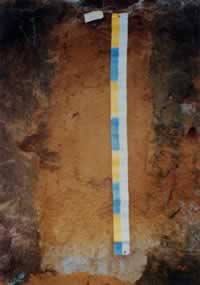
Lintang
The extent of quartzipsomments in Malaysia has not been reported. However, they are known to occur extensively besides mining or ex-mining areas and flat river basins. Some of these soils are classified as Sg. Buloh, Subang, Nangka, Lintang and Jambu series. The major limitations of these soils mirror those of podzols except that perched water table does not exist.
The management procedures for oil palms on these sandy soils are similar to those on podzols except that scupper drains are not dugged. Our experience with plantings on these soils has been fortunate because they occur in high rainfall regions of Central Perak and Southern Kedah. Their yield performances are shown in Figure 7 also.
Problem Soils: Managing Podzols or Spodosols
[addw2p name=”problemSoils”]
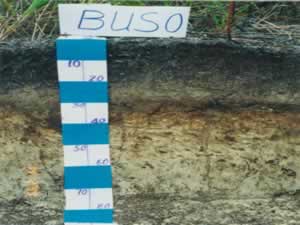
Buso
Podzols generally occur within BRIS (Beach Ridges Interspersed with Swales) soils although they have been found on moderate hills in East Malaysia. The total extent of these soils in Peninsular Malaysia alone has been estimated at 162,000 ha (Choo, 1991). Majority of these soils are used for tobacco, vegetables, cashew nut trees and star-fruit trees. Of late, some of these soils which occur in the plantations have been cultivated with oil palms.
The major constraints in Podzols are perched water table, low nutrient status and CEC and poor moisture retention capacity. Some podzols may not have perched water table and these soils resemble quartzipsamments, which are discussed later.
The obvious first priority is to remove the stagnant water on the soil surface. This is easily accomplished by digging scupper drains with lower depths breaking the hard spodic horizons. The intensity of drains is usually 1 in 8 palm rows although this varies with sites. The top width of the drain is 60 cm and the bottom width is 30 cm to allow for more gentle slope, therefore easier maintenance.
Upon surface drainage, the conditions reverted to the other extreme of likely severe moisture stress due to excessive drainage and low moisture retention capacity. Hence, water conservation practices similar to those described for lateritic soils earlier must be improved immediately. The EFB mulching rate should be increased to 60 to 80 t ha-1 yr-1 and this is continued for at least 5 years before a lower rate is adopted.
The poor nutrient status and retention capacity pose a dilemma of high total fertiliser input but low rate at each application. This is generally solved by using compound or mixture fertilisers supplemented with straight fertilisers. The total fertiliser applications may reach 7 to 9 rounds a year and this should minimise leaching losses. Despite the sandy soils with anticipated low P fixing capacity, high phosphate rock is still recommended to ensure good root development and activity. Very high rate of ground magnesium limestones (GML) is also necessary to build-up the soil Mg status and prevent Mg deficiency.
Good ground vegetation is also important in reducing the surface soil temperature, which helps to reduce soil water evaporation and improve microbiological activity. The leaf litter return also binds the soil particles for better structure and aggregation.
Our experiences with planting oil palms on Podzols with satisfactory rainfall or more than 2000 mm yr-1 has been encouraging as shown in Figure 7.
Problem Soils: Managing Shallow Lateritic Soils
[addw2p name=”problemSoils”]

Jitra
Shallow lateritic soils such as Malacca and Gajah Mati series, and their associated soils occupy 0.6 million hectares in Peninsular Malaysia (Law and Selvadurai, 1968). Early experiences indicated that oil palms grown on shallow lateritic soils came into bearing two years later and three times less compared to deep soils (Tan and Thong, 1975; Pang et al., 1977). Increasing the fertiliser rates only partially alleviate the constraint and improve yield by –% (Tan, 1973). Productivity also seems to improve with palm age (Tayeb et al., 1991).
These results show that the main problems with shallow lateritic soils are low effective soil volume, poor nutrient status and water holding capacity. These detriments further hinder root development, which aggravates oil palm growth and production. It has to be mentioned that the types and compactness of the laterites also play a major role on the degree of severity of limitations to oil palms. For example, the less compact and subangular laterites of Jitra series pose only moderate limitation to oil palms compared to very serious limitation in Malacca series despite both being shallow lateritic soils.
The main approaches to obtain satisfactory oil palms on shallow lateritic soils are to improve soil fertility and implement soil and water management adroitly. Improvement in soil fertility is necessary to increase nutrient uptake per unit soil volume. Since most lateritic soils are well weathered with low CEC and high P fixing capacity, it is necessary to maintain high and balanced rates of manuring as well as frequent applications to the palms. It is also essential to apply very large quantity of phosphate rocks to ensure sufficient P for good rooting activity.
The primary aims of soil and water management here are to reduce run-off and soil erosion, and build-up organic matter in the soil. These are achieved by:
-
maintain desirable ground vegetation such as legumes during immaturity to early maturity phase and light grasses and Nephrolepis biserrata in later years,
-
Spread the pruned fronds as broadly as possible. In flat areas, L-shaped frond stacking should be carried out while in terraced areas, they should be staked on the terraced lips and between the palms along the terraces,
-
terraces must have sufficient back-slope and regular stops along the terraces to trap soil and water,
-
mulching with empty fruit bunches (EFB) if available
Irrigation should only be conducted if it is economically viable, easy to maintain and a ready source of water during the dry season is available as mentioned in Part I of this lecture notes.
It is also advisable to increase the planting density to 148 palms ha-1 and extend ablation by 3 to 6 months for maximum leaf area index and high better yields.
Proper implementation of above soil fertility, and soil and water managements had raised the oil palm. Yields on commercial scale as shown in Figure 6.

